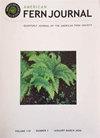欧洲紫檀(Pteridae)潜在的耐旱性
IF 0.9
4区 生物学
Q4 PLANT SCIENCES
引用次数: 1
摘要
欧洲紫檀属植物潜在的耐旱性--有足够的水生存是生物体必须应对的限制之一。已经进化出许多策略,使生物体能够在低水条件下生存。在植物中,一种这样的策略是耐旱性:在光合组织中几乎完全失去水分的情况下生存的能力(Walter,《植物生理学年度评论》6:239-252)。1955年;Schwab&Heber,Planta 161:37–45。1984年;Gaff,《对环境应力的结构和功能响应》,225–268。1989年;Rascio和La Rocca,《植物科学评论》24:209-255。2005),这种策略也在地衣等其他生物中发现。尽管耐旱性可能是所有陆地植物的祖先状态(Gaff&Oliver,Functional Plant Biology 40:315-328。2013),自从它们迁移到陆地以来,植物对干燥的耐受性已经出现了多次(Oliver等人,植物生态学151:85–100。2000年;Oliver等人,《综合与比较生物学》45:788–799。2005年;Kirkpatrick,博士论文。2008)。它仍然普遍不常见,除了某些类群,如苔藓植物(Proctor et al.,The Bryologist 110:595-621)。2007)。然而,它似乎在蕨类植物科(即cheilanthoid蕨类植物)的xericadapted成员中相对常见,在Astrolepis的几个物种中有报道(Kirkpatrick,博士论文.2008),Cheilanthes s.l.(Gaff,Oecologia 74:133-136)。1987年;Proctor&Tuba,新植物学家156:327-349。2002年;Kirkpatrick,博士论文。2008),Notholaena(Kessler&Siorak,《美国蕨类杂志》97:175-185。2007)和Pellaea,以及Argyrochoma fendleri和Bommeria hispida(Kirkpatrick,博士论文。2008)。在这里,我提出了一个关于Cheilanthes ecuadorensis Windham&K.Sosa的潜在干燥耐受性的进一步记录,该记录非常广泛地描述了Cheilanthens ecuadorenis Windham&K.Sosa的干燥和恢复时间,这是一个最近描述的来自厄瓜多尔的物种,仅从植物标本中已知(Sosa等人,《系统植物学》46:249–259。2021)。本文章由计算机程序翻译,如有差异,请以英文原文为准。
Potential Desiccation Tolerance Shown in Cheilanthes ecuadorensis (Pteridaceae)
Potential Desiccation Tolerance Shown in Cheilanthes ecuadorensis (Pteridaceae).—Having enough water for survival is one of the restrictions with which organisms must cope. Many strategies have evolved that allow organisms to survive in low-water conditions. Among plants, one such strategy is desiccation tolerance: the ability to survive an almost complete loss of water in photosynthetic tissues (Walter, Annual Review of Plant Physiology 6:239–252. 1955; Schwab & Heber, Planta 161:37–45. 1984; Gaff, in Structural and Functional Responses to Environmental Stresses, 225–268. 1989; Rascio & La Rocca, Critical Reviews in Plant Sciences 24:209–255. 2005), a strategy that is also found in other organisms such as lichens. Although desiccation tolerance is likely the ancestral state for all land plants (Gaff & Oliver, Functional Plant Biology 40:315–328. 2013), vegetative desiccation tolerance has arisen multiple times since their move to land (Oliver et al., Plant Ecology 151:85–100. 2000; Oliver et al., Integrative and Comparative Biology 45:788– 799. 2005; Kirkpatrick, PhD Dissertation. 2008). It remains broadly uncommon, except in certain groups such as bryophytes (Proctor et al., The Bryologist 110:595–621. 2007). However, it appears to be relatively common in the xericadapted members of Pteridaceae (i.e., cheilanthoid ferns), being reported in several species of Astrolepis (Kirkpatrick, PhD Dissertation. 2008), Cheilanthes s.l. (Gaff, Oecologia 74:133–136. 1987; Proctor & Tuba, New Phytologist 156:327–349. 2002; Kirkpatrick, PhD Dissertation. 2008), Notholaena (Kessler & Siorak, American Fern Journal 97:175–185. 2007) and Pellaea, as well as in Argyrochosma fendleri and Bommeria hispida (Kirkpatrick, PhD Dissertation. 2008). Here I present a further record of potential desiccation tolerance exhibited in cheilanthoid ferns, describing very broadly time to desiccation and recovery in Cheilanthes ecuadorensis Windham & K.Sosa, a recently described species from Ecuador that is known only from herbarium specimens (Sosa et al., Systematic Botany 46:249–259. 2021).
求助全文
通过发布文献求助,成功后即可免费获取论文全文。
去求助
来源期刊

American Fern Journal
生物-植物科学
CiteScore
1.20
自引率
0.00%
发文量
28
审稿时长
6 months
期刊介绍:
The American Fern Journal is a peer-reviewed journal focused on the biology of ferns and lycophytes.
 求助内容:
求助内容: 应助结果提醒方式:
应助结果提醒方式:


